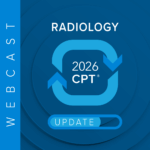The 2023 final Medicare Physician Fee Schedule (PFS) rule is set to shackle radiology-related policy and bind stakeholders for the coming year. The rule was released by the Centers for Medicare & Medicaid Services (CMS) on November 1st with changes effective on January 1, 2023. Radiology providers and imaging centers should prepare for impending payment cuts and adapt to other policy changes. The rule addresses payment provisions and aims policy creation centered around the Quality Payment Program (QPP) implementation, along with the Merit-Based Incentives Payment System (MIPS) and Advanced Alternative Payment Models (APMs) among others. Notify your staff of these updates.
Reimbursement Consequences
As expected, CMS touted the release of the final rule with multiple statements included in their news release promising a more progressive future for Medicare and its related policies.
“The Biden-Harris Administration is committed to expanding access to vital prevention and treatment services. Providing whole person support and services through Medicare will improve health and wellbeing for millions of Americans and even save lives,” HHS Secretary Xavier Becerra stated.
CMS Administrator Chiquita Brooks-LaSure praised: “Access to services promoting behavioral health, wellness, and whole-person care is key to helping people achieve the best health possible. The Physician Fee Schedule final rule ensures that the people we serve will experience coordinated care and that they have access to prevention and treatment services for substance use, mental health services, crisis intervention, and pain care.”
“Together, we are building a stronger Medicare program,” said Deputy Administrator and Director for the Center for Medicare, Dr. Meena Seshamani said in the CMS statement. “No matter who you are, or what diagnoses you have, these changes will help ensure that Medicare treats the whole person—caring for physical health, behavioral health, and social needs that are integral to health—and ensuring access to the high-quality care all people deserve.”
For radiology reimbursement, the conversion factor changes tell a strikingly different story representing a downward spiral that endangers the financial health of many stakeholders and places patient care at risk. The 2023 conversion factor is down to $33.06 from a conversion factor of $34.60. According to the American College of Radiology (ACR), CMS created its calculations “by first removing the one-year 3 percent increase provided by the Protecting Medicare and American Farmers from Sequester Cuts Act and then applying a negative 1.60 percent budget neutrality update. The budget neutrality update is due to revaluation of several evaluation and management code families, including hospital, emergency medicine, nursing facility and home visits.”
Radiology will experience a two percent decrease, while interventional radiology will brace for an aggregate decrease of three percent. Nuclear medicine can expect to see a two percent decrease, with radiation oncology and radiation therapy centers preparing for a one percent decrease. On the upside, these reductions do not represent the full reductions contained in the proposed rule, offering a small reprieve, with CMS acting to correct an error in the calculation of the malpractice relative value units (RVUs).
One factor in the decrease comprises changes in the RVUs and the second year of the transition to clinical labor pricing updates. The ACR warns yet again though that “If Congress does not intervene to extend the 3 percent increase provided by the Protecting Medicare and American Farmers from Sequester Cuts Act, the percent decreases mentioned above will be greater for CY 2023.”
Telehealth Services Take Flight into the Future
With telehealth policies becoming valuable tools during the pandemic, CMS sought to finalize a multitude of policies encompassing Medicare telehealth services. One major benefit finalized was extending the temporary availability of some key services through end of the year 2023, as telehealth services for the public health emergency (PHE) on a Category III basis. This is especially beneficial because it grants more time for data collection that may be employed to support the use of these policies as permanent tools within the Medicare telehealth services list.
Even more, CMS cemented its policy that directs the implementation of the telehealth provisions in the Consolidated Appropriations Act of 2022. This is occurring through directions in program instruction or other sub-regulatory guidance. The policies act to grant specific flexibilities over the course of the PHE for a full 151 days following the conclusion of the PHE. The power of this policy is that telehealth services are legally allowed to be completed “in any geographic area and in any originating site setting, including the beneficiary’s home, allowing certain services to be furnished via audio-only telecommunications systems, and allowing physical therapists, occupational therapists, speech-language pathologists, and audiologists to furnish telehealth services.”
Lastly, CMS maintained the proposal to enable both physicians and practitioners the ability to continue billing using the place of service (POS) indicator normally reported should the service have been completed in person.
A Win for Valuation of Imaging Services Updates
In a win for radiology, CMS approved the Relative Value Scale Update Committee (RUC) recommended values for ten radiology-related codes. Among the noteworthy wins are an increase for values of contrast x-ray of the knee joint along with the percutaneous arteriovenous fistula creation code family.
Here, the ACR obtained an advocacy win, with CMS acting on the college’s comments and electing to revise its values for the neuromuscular ultrasound code family in the final rule. This is in contrast to the initially proposed cut in value. CMS is seeking to maintain the RUC-recommended direct practice expense inputs for both the neuromuscular ultrasound codes and the percutaneous arteriovenous fistula creation codes as the result of industry stakeholder comments.
Explore more regulatory, policy, and coding knowledge to master compliance and coding with our monthly Radiology Compliance Manager.
Information Sources:
https://public-inspection.federalregister.gov/2022-23873.pdf
https://www.acr.org/-/media/ACR/Files/Advocacy/MPFS/ACR-Preliminary-Summary-2023-MPFS-FR-FINAL_11_1_22.pdf
https://www.cms.gov/newsroom/fact-sheets/calendar-year-cy-2023-medicare-physician-fee-schedule-final-rule
https://www.cms.gov/newsroom/press-releases/hhs-finalizes-physician-payment-rule-strengthening-access-behavioral-health-services-and-whole













